What’s the difference between a $5 chicken, a $25 chicken, and a $45 chicken? Some might say that all chicken is basically the same, but if you look into the process that brings them to your store’s refrigerated section, you’ll find that they can be quite different. The cost of a chicken depends on the cost to produce it at every stage. I spoke with Mathew Dix of North Tabor Farm and Jim Athearn of Morning Glory Farm, both of whom raise about a thousand broiler chickens each year. There are many similarities between what happens on each farm, but there are two key differences — breed and feed.
The most common breed of broiler is the Cornish Cross, and that’s what you’ll find on supermarket shelves. This chicken is overwhelmingly popular for its fast growth and efficient conversion of feed into meat. In industrial farming, the Cornish Cross is pretty much the only game in town, but what we have on the Vineyard is not industrial farming. For those who want a chicken that’s more flavorful, and one that’s enjoyed a longer life, there are several heritage breeds. Dual purpose breeds, like the New Hampshire Red, are used for both eggs and meat, and can take four months or more to reach full weight. That makes them impractical as commercially raised meat birds.
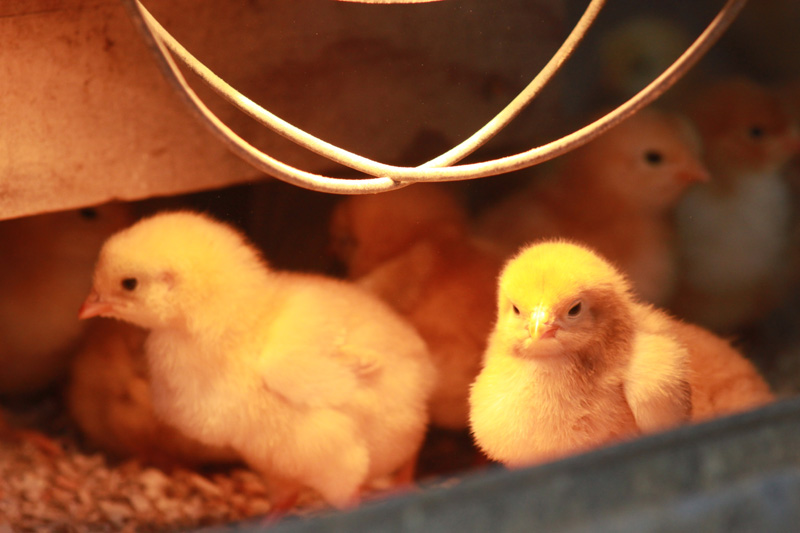
North Tabor Farm raises Imperial Broilers, a bird that grows faster than a dual-purpose chicken, but is heartier and slower-growing than the Cornish Cross. It also has a narrower breast, bigger legs and more dark meat, which makes for a better texture and more flavor, according to the experts. Although the breed has lower mortality as chicks and on the range, raising them is still fraught with uncertainty. Day-old chicks come to the Island from the hatchery through the U.S. mail. When chicks hatch they’re able to safely go 24 hours without eating, so most arrive alive and well — although a few don’t. Matthew orders them in weekly batches of about 40, whereas the broilers at Morning Glory, which are Cornish Crosses, arrive at the farm in batches of 85 every two weeks. Of these, Mathew expects about 90 percent to survive, whereas Jim figures on about 75 of the original 85 reaching the market. The every-two-weeks delivery and processing cuts down on costs, but it means that some weeks Morning Glory only has frozen chickens for sale. The Imperial Broiler chicks also cost more, even though Matthew chooses the most economical option for them — a straight run that mixes male and female chicks.
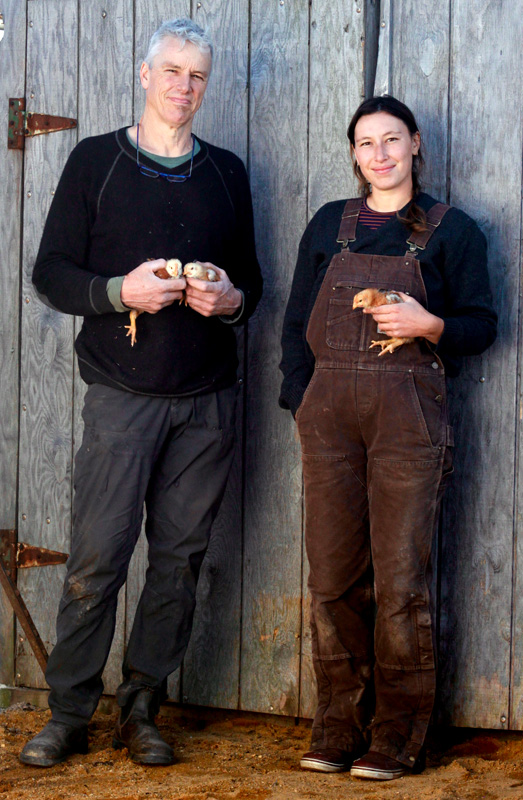
Matthew keeps the chicks in his brooder, a rat-proof old horse trailer, for four weeks before moving them out to pasture for another five to six weeks. Rats can be a major problem. Jim Athearn says that he once lost an entire batch of chicks: they were wiped out by rats in one night, killed but not eaten. On the pasture at Morning Glory, the growing broilers live in a “tractor,” a square or rectangular frame with solid sides and a roof on one end, and covered with chicken wire mesh on the other side. It’s open to the air and set on the grass. Every day, the farmer brings food and water and moves the tractor to a fresh patch of pasture, where the chickens can graze on bugs and grass. As they go, they fertilize the soil. And with the daily move, sometimes a chicken will slip out. “If chicks get out of the tractor, if you don’t find them the hawks will,” Jim says.
“Raccoons don’t dig, but are troublesome for chickens if you don’t have a good fence,” Matthew says. Jim says that skunks will tunnel under the sides to get to the grain, and if the chicks look susceptible, they’ll get eaten too. Coyotes could become a problem here, but so far they haven’t been. The North Tabor chicks are pastured on Land Bank property near the farm, and on another nearby horse pasture. Jim keeps his chicken tractors on the hillside behind his house, land that’s too sloped for vegetable growing. “When you build a henhouse, you build it next to your house so you can get out and shoot the raccoons when they come in the middle of the night,” he says.
Throughout this time, the birds have to eat. According to one hatchery, it takes less than two pounds of feed to produce one pound of dressed (plucked and gutted) Cornish Cross chicken. In contrast, the Imperial Broiler needs 2.3 to 3 pounds of grain per pound of dressed weight to get up to full size. This makes a significant difference in cost, but the cost of organic versus conventional feed is a bigger factor. Morning Glory gets their chicken feed from a granary in Taunton, whereas North Tabor Farm sources their organic feed from a granary in upstate New York. Between slower growth, transportation costs, and the additional cost of organic feed, the Imperial Broilers at North Tabor Farm have a diet that’s about twice as expensive as that of the Cornish Cross broilers at Morning Glory.
After the chickens have eaten their fill, it’s time for processing. If you’ve ever tried to process a chicken yourself, you’ll appreciate the effort that it takes for an amateur to turn an extra rooster or an old hen into stew meat. Having tried it a few times myself, I know that I’m never going to make it a regular part of my life. The last time I plucked and gutted an old rooster, it took about an hour. A cold, frustrating hour. The Athearns also have hens for eggs, and tried to see if some meat could be gotten out of them. “We tried spent hens but they yielded so little meat,” Jim says. “My sons and I did it, it came to about two pounds of meat per bird when it was pulled off the bone and it just took us hours. We probably made about $6 on it.” While they might have made good broth, it was far too much effort. “Processing old laying hens is nasty,” Matthew says, “and there’s not much meat. Meat birds have bigger cavities and aren’t as sharp inside as laying hens.”
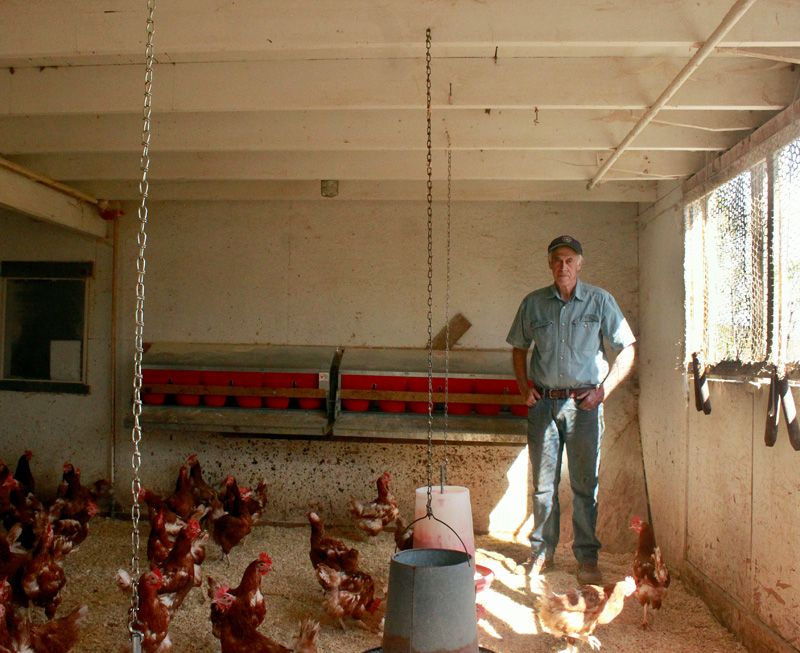
Until 2010, no one on the Vineyard was raising chickens commercially for meat. Island Grown Initiative’s mobile processing unit made raising broilers a viable possibility. Their mobile poultry slaughterhouse program was headed up by executive director and founder Ali Berlow and Richard Andre. The equipment and training costs were around $12-$14,000 in 2007, which would have been out of reach for individual Island farms. After Berlow left IGI, she went on to write “The Mobile Slaughterhouse: Building a Humane Chicken Processing Unit to Strengthen Your Local Food System” (Storey Publishing), while farmers Richard Andre, Jefferson Munroe, and Matthew Dix continued the work. Dix ran the mobile processing unit for years, and he does a lot of the work when he brings it to North Tabor Farm to process his chickens. As of the summer of 2022, Marc Piland was managing the unit. “Marc is very fast with the evisceration,” Matt says. “There’s a bit of muscle memory involved — you need to be very good at it and most people don’t want to do it. The summer interns get good after a few weeks. It’s not a full-time job, not that you would want it to be a full-time job.” Morning Glory Farm also relies on the mobile unit, and others who want to raise chickens for meat have to make sure that their processing dates line up with when the unit is available.
The Imperial Broilers reach about four to five pounds in about nine to ten weeks, while the Cornish Cross broilers are about 5 ½ pounds at seven to eight weeks old. The tricky thing is that the Cornish Cross birds can’t live much longer than that — they keep growing and don’t stay healthy, so the timing of the processing has to be precise. The Imperial Broilers have more flexibility. Matthew doesn’t take all of them to process at once, but chooses the biggest 30 or 40 from the lot each time the processing unit comes. Although processing is a lot of work, it can be done quickly by experienced people using specialized equipment. “When you’re done, it’s only two to three hours of work for 30 or 40 birds,” Matthew says, “plus the work of setup and cleanup of the equipment.” Take all that into account, and it’s a pretty long half-day of work.
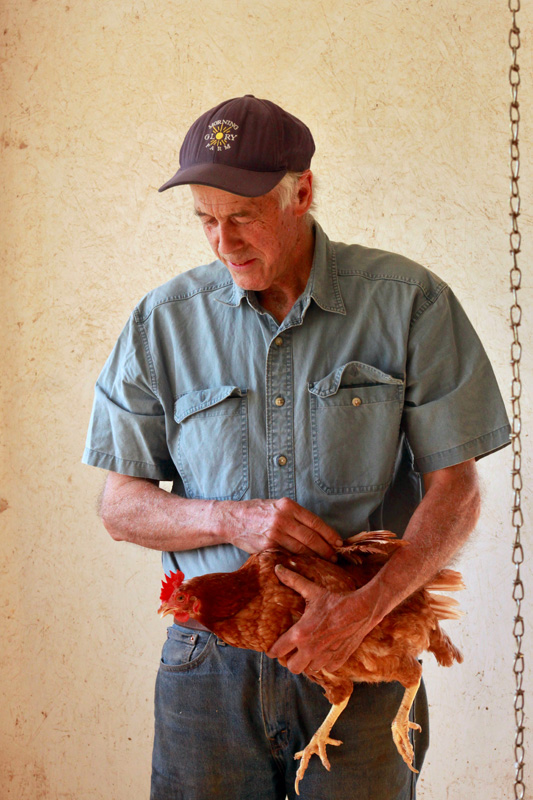
Finally, they go to the market, or in this case, the farmstand. North Tabor Farm’s farmstand is quite small, and focuses on all-organic foods. The chickens sell for $10 per pound, a price that’s gone up recently due to the increased cost of labor. “We try to create a little full service farmstand here. You never make a lot of money on any one thing — I like to do a bit of everything.” Matthew tries to have fresh chickens all through the season, which means weekly processing from May into December. Morning Glory’s farmstand is bigger, but the fundamental philosophy is similar. “We like to provide any food we can in the Island diet,” Jim says. He doesn’t count his own labor into the cost of the chickens, but he does have employees, as well as the cost of processing. Taking all of that into consideration, Morning Glory priced the broilers at $5.45 per pound last year.
The price of a frugally but locally raised chicken doesn’t come close to comparing to the ones in big discount stores off-Island, which sell for about $1.30 per pound as of this writing. However, the conditions those chickens live in are a far cry from grazing on pastureland on the Vineyard, and the farmers who grow them on behalf of large corporations often don’t fare so well either. Although all of these chickens are part of the same species, the breed, the process, and the farms where they are raised can be very different indeed. The chicken we roast, boil, or broil has a history that impacts both the world around it and its taste, and it might be worth trying something new, even if it does cost more.

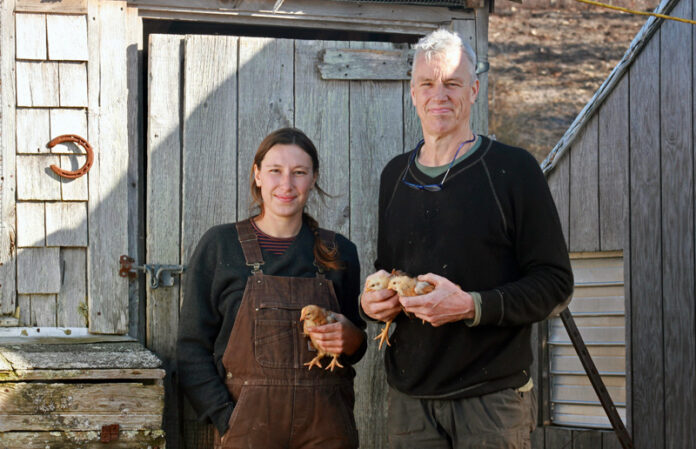

The Island has hosted domestic poultry operations since the European settlers arrived in the mid 1600’s. The Martha’s Vineyard Museum has a wonderful collection of papers from Maurice Delano who ran Owen Farms, which had a national and international reputation between 1905 and 1930. While Owen Farms raised 6000 birds for meat and egg production, its fame came from its “fancy” poultry operation, which shipped show birds all over the country. In Delano’s own words “I breed the best buff and white Orpingtons, white Plymouth Rocks, white Wyandottes and small comb Rhode Island Reds in America.”
The modern broiler industry has historic roots here in Massachusetts. A gentleman named Robert C Cobb Senior purchased a farm in Littleton in 1916 and a decade later was leading the industry as a breeder of Barred Plymouth Rocks, part of the parentage of the highly popular and hugely successful Cornish-Rock cross. In the 1940’s Cobb was breeding a line of white birds knows as White Rocks and paired this with a male line from Vantress. The company was very successful and well-respected, and was (is) a major global influence. In 1974 they were purchased by the Upjohn Company, and Tyson Foods acquired the Vantress line, and in 1986 Tyson and Upjohn formed a joint venture known Cobb-Vantress. They have continued to grow and are, in fact, one of the three dominant suppliers of breeding stock.
In addition to the work that Jefferson and Richard did, Julie Olson Scott -now at Slough Farm, then at The Farm Institute -was instrumental in promoting and refining the process. Her efforts led to The Farm Institute having a state-certified fixed processing facility at TFI from 2009? I think to perhaps 2017 when the Trustees took over. For a few years TFI raised and processed a breed (for comercial sale) that she had found called Freedom Rangers, a distinct alterrnative (and we thought, an improvement) over the Cornish Cross. And yes, as Jim says, spent hens are a pain to processs. We do a few in the fall if we can find them but they sure make great stock and broth.
Comments are closed.